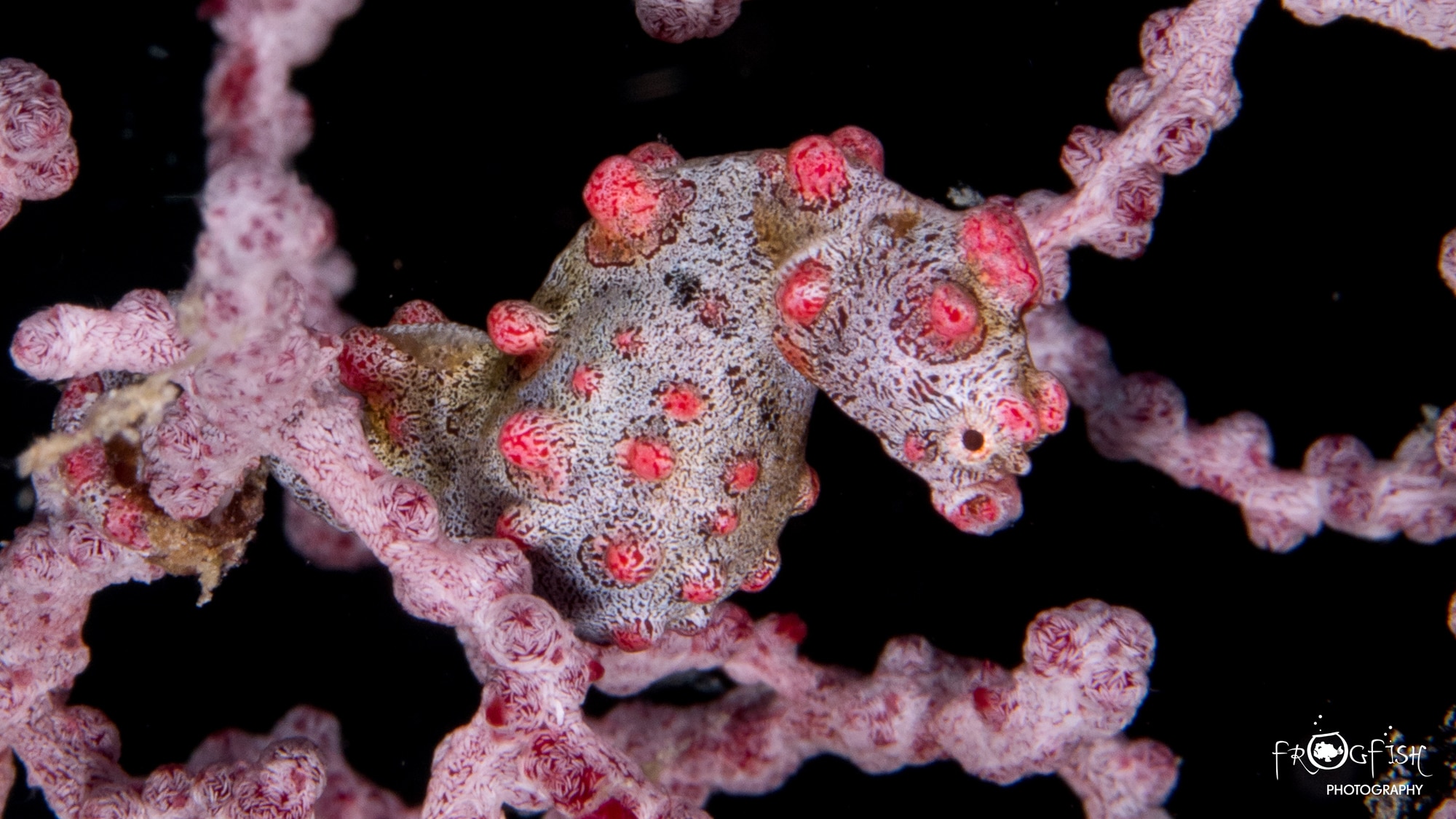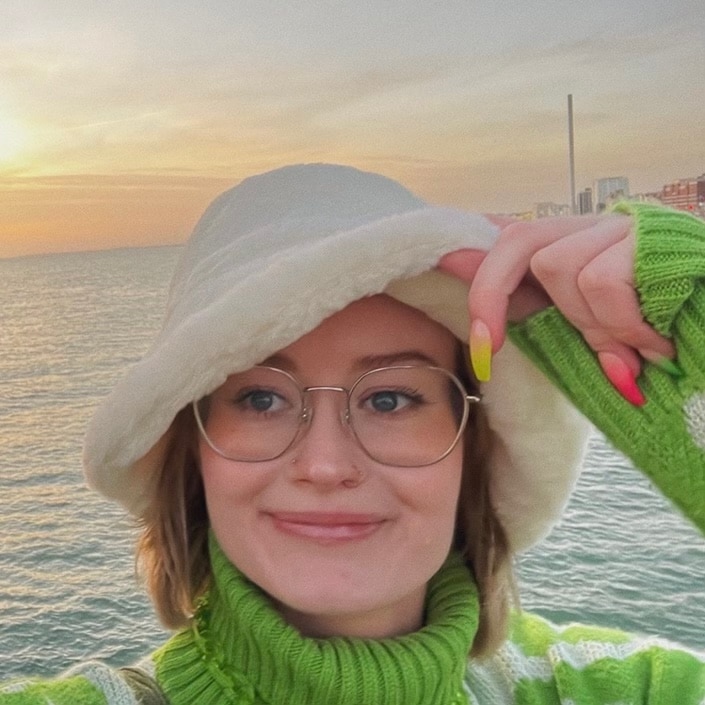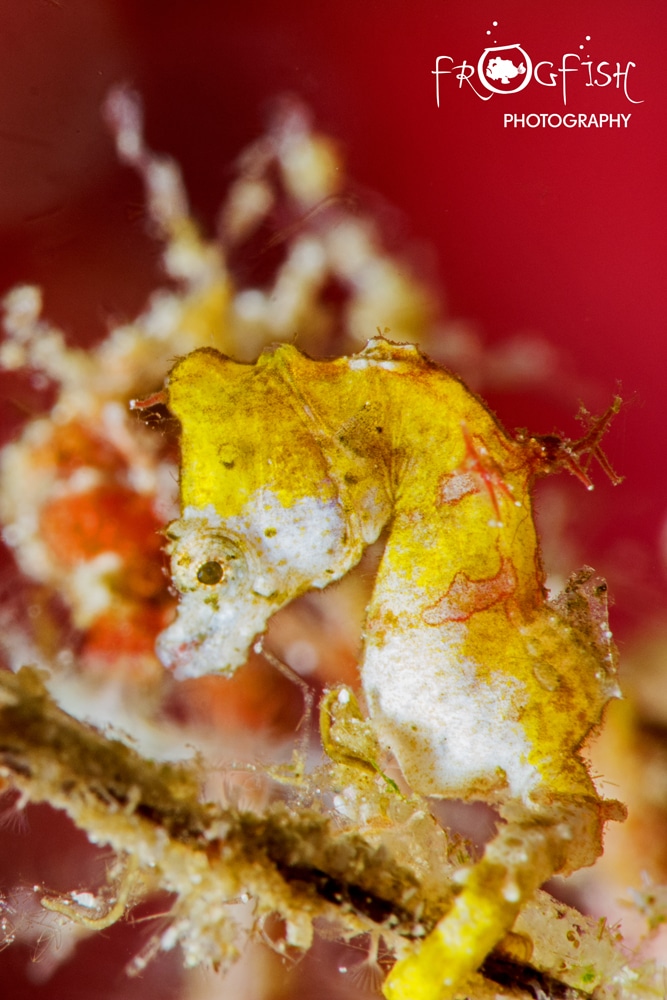Marine Life & Conservation Blogs
Seahorses

A guest blog from Isobel Fairbairn
When I was younger, I’m sure I always wanted to meet a unicorn; maybe one day I still will! Though as I got older, I realised the more interesting (and more likely) horse to come across in the wild is the Seahorse.
Although I haven’t yet had that opportunity besides in the odd aquarium, the best time to go out looking for them would be summer as the warmer months is when they reside in shallower waters, before going deeper into the ocean in winter to avoid the harsher weather. There are approximately 54 species (and counting) varying in size found in different spots all over the world, even recently being spotted in the River Thames!
Seahorses come from the genus Hippocampus, which comes from the Greek Híppokampos, Híppos meaning horse and Kámpos meaning sea monster.
Possibly their most interesting fact is that the male Seahorses are the ones to give birth, being as they’re one of the only species in the world to do this, it’s also possibly the most well-known Seahorse fact! This has its purpose though, as this then frees up the female Seahorse to start making even more eggs.
The males take these eggs from the female, self-fertilise and incubate them, the gestation period can range from 14 days to 14 weeks, then proceed to give birth to baby Seahorses, known as “Frys”. The amount of frys that are produced depends on the species size, ranging from 50-150 babies in smaller species to 1500 in larger species.
Although they be but small, their eyesight is mighty… Seahorses eyes work independently from one another for extra excellent vision, this helps them to hunt and protect themselves. Oddly they also sleep with their eyes open, this is due to the fact they don’t have eyelids. While sleeping they cling onto coral to stop themselves floating away… flying should be left to the unicorns in this case!
As magical as Seahorses may sound, in many cases they, on paper, sound a lot more like monsters than fairy horses, with their complex exoskeleton- fused together with a flesh type covering and a tendency to accidentally eat their own babies… because they look so much like tiny crustaceans (if you ask me, that sounds like an excuse a Seahorse would make up). They can consume up to 3,000 or more brine shrimp a DAY! They manage all that shrimp with no teeth!
We all have weak spots but being a bad swimmer while living in the OCEAN really shows that God does have favourites, sadly for the Seahorse this is indeed the case. These not so strong swimmers use their dorsal fins for power, beating them 30-70 times per second.
Now although not much of that seemed too appealing, Seahorses are still special creatures who need our protection and care. Both species of Seahorse found in the U.K are already protected under the Wildlife and Countryside act (1981). They are at risk all over the world; Chinese medicine take up to 150million Seahorses per year. They are also often snatched from the sea, left to boil in the sun and sold as souvenirs- a horrifying thought.
Seahorses are not exempt from the pet trade either, often caught and sold, then barely surviving in trade conditions for longer than several weeks.
So, remember, if you see a Seahorse in the wild, leave it as untouched as you would a unicorn.
 Isobel Fairbairn is a 22 year old first year Marine Biology student at the university of Salford with a passion for both writing and marine life. “I loves to share things that I learn along my journey and that’s when I decided I wanted to take my career towards writing, I’ve always wanted to write but when my two passions collided I knew I had to go in this direction.”
Isobel Fairbairn is a 22 year old first year Marine Biology student at the university of Salford with a passion for both writing and marine life. “I loves to share things that I learn along my journey and that’s when I decided I wanted to take my career towards writing, I’ve always wanted to write but when my two passions collided I knew I had to go in this direction.”
She lives in Manchester. Her favourite fish is the Chimera Shark and she is currently undergoing her diving training with BSAC with the university’s diving society. “I am equal parts terrified and excited.”
Instagram: @ihf.media
Marine Life & Conservation Blogs
Creature Feature: Dusky Shark

 In this series, the Shark Trust will be sharing amazing facts about different species of sharks and what you can do to help protect them.
In this series, the Shark Trust will be sharing amazing facts about different species of sharks and what you can do to help protect them.
This month we’re taking a look at the Dusky Shark, a highly migratory species with a particularly slow growth rate and late age at maturity.
Dusky sharks are one of the largest species within the Carcharhinus genus, generally measuring 3 metres total length but able to reach up to 4.2 metres. They are grey to grey-brown on their dorsal side and their fins usually have dusky margins, with the darkest tips on the caudal fin.
Dusky Sharks can often be confused with other species of the Carcharhinus genus, particularly the Galapagos Shark (Carcharhinus galapagensis). They have very similar external morphology, so it can be easier to ID to species level by taking location into account as the two species occupy very different ecological niches – Galapagos Sharks prefer offshore seamounts and islets, whilst duskies prefer continental margins.
Hybridisation:
A 2019 study found that Dusky Sharks are hybridising with Galapagos Sharks on the Eastern Tropical Pacific (Pazmiño et al., 2019). Hybridisation is when an animal breeds with an individual of another species to produce offspring (a hybrid). Hybrids are often infertile, but this study found that the hybrids were able to produce second generation hybrids!
Long distance swimmers:
Dusky sharks are highly mobile species, undertaking long migrations to stay in warm waters throughout the winter. In the Northern Hemisphere, they head towards the poles in the summer and return southwards towards the equator in winter. The longest distance recorded was 2000 nautical miles!
Very slow to mature and reproduce:
The Dusky Shark are both targeted and caught as bycatch globally. We already know that elasmobranchs are inherently slow reproducers which means that they are heavily impacted by overfishing; it takes them so long to recover that they cannot keep up with the rate at which they are being fished. Dusky Sharks are particularly slow to reproduce – females are only ready to start breeding at roughly 20 years old, their gestation periods can last up to 22 months, and they only give birth every two to three years. This makes duskies one of the most vulnerable of all shark species.
The Dusky Shark is now listed on Appendix II of the Convention on the Conservation of Migratory Species (CMS), but further action is required to protect this important species.
Scientific Name: Carcharhinus obscurus
Family: Carcharhinidae
Maximum Size: 420cm (Total Length)
Diet: Bony fishes, cephalopods, can also eat crustaceans, and small sharks, skates and rays
Distribution: Patchy distribution in tropical and warm temperate seas; Atlantic, Indo-Pacific and Mediterranean.
Habitat: Ranges from inshore waters out to the edge of the continental shelf.
Conservation status: Endangered.
For more great shark information and conservation visit the Shark Trust Website
Images: Andy Murch
Diana A. Pazmiño, Lynne van Herderden, Colin A. Simpfendorfer, Claudia Junge, Stephen C. Donnellan, E. Mauricio Hoyos-Padilla, Clinton A.J. Duffy, Charlie Huveneers, Bronwyn M. Gillanders, Paul A. Butcher, Gregory E. Maes. (2019). Introgressive hybridisation between two widespread sharks in the east Pacific region, Molecular Phylogenetics and Evolution 136(119-127), https://doi.org/10.1016/j.ympev.2019.04.013.
Marine Life & Conservation Blogs
Creature Feature: Undulate Ray

 In this series, the Shark Trust will be sharing amazing facts about different species of sharks and what you can do to help protect them.
In this series, the Shark Trust will be sharing amazing facts about different species of sharks and what you can do to help protect them.
This month we’re looking at the Undulate Ray. Easily identified by its beautiful, ornate pattern, the Undulate Ray gets its name from the undulating patterns of lines and spots on its dorsal side.
This skate is usually found on sandy or muddy sea floors, down to about 200 m deep, although it is more commonly found shallower. They can grow up to 90 cm total length. Depending on the size of the individual, their diet can range from shrimps to crabs.
Although sometimes called the Undulate Ray, this is actually a species of skate, meaning that, as all true skates do, they lay eggs. The eggs are contained in keratin eggcases – the same material that our hair and nails are made up of! These eggcases are also commonly called mermaid’s purses and can be found washed up on beaches all around the UK. If you find one, be sure to take a picture and upload your find to the Great Eggcase Hunt – the Shark Trust’s flagship citizen science project.
It is worth noting that on the south coasts, these eggcases can be confused with those of the Spotted Ray, especially as they look very similar and the ranges overlap, so we sometimes informally refer to them as ‘Spundulates’.
Scientific Name: Raja undulata
Family: Rajidae
Maximum Size: 90cm (total length)
Diet: shrimps and crabs
Distribution: found around the eastern Atlantic and in the Mediterranean Sea.
Habitat: shelf waters down to 200m deep.
Conservation Status : As a commercially exploited species, the Undulate Ray is a recovering species in some areas. The good thing is that they have some of the most comprehensive management measures of almost any elasmobranch species, with both minimum and maximum landing sizes as well as a closed season. Additionally, targeting is entirely prohibited in some areas. They are also often caught as bycatch in various fisheries – in some areas they can be landed whilst in others they must be discarded.
IUCN Red List Status: Endangered
For more great shark information and conservation visit the Shark Trust Website
Image Credits: Banner – Sheila Openshaw; Illustration – Marc Dando
-

 News3 months ago
News3 months agoHone your underwater photography skills with Alphamarine Photography at Red Sea Diving Safari in March
-

 News3 months ago
News3 months agoCapturing Critters in Lembeh Underwater Photography Workshop 2024: Event Roundup
-

 Marine Life & Conservation Blogs2 months ago
Marine Life & Conservation Blogs2 months agoCreature Feature: Swell Sharks
-

 Blogs2 months ago
Blogs2 months agoMurex Resorts: Passport to Paradise!
-

 Blogs2 months ago
Blogs2 months agoDiver Discovering Whale Skeletons Beneath Ice Judged World’s Best Underwater Photograph
-

 Marine Life & Conservation2 months ago
Marine Life & Conservation2 months agoSave the Manatee Club launches brand new webcams at Silver Springs State Park, Florida
-

 Gear Reviews3 months ago
Gear Reviews3 months agoGear Review: Oceanic+ Dive Housing for iPhone
-

 Gear Reviews2 weeks ago
Gear Reviews2 weeks agoGEAR REVIEW – Revolutionising Diving Comfort: The Sharkskin T2 Chillproof Suit























